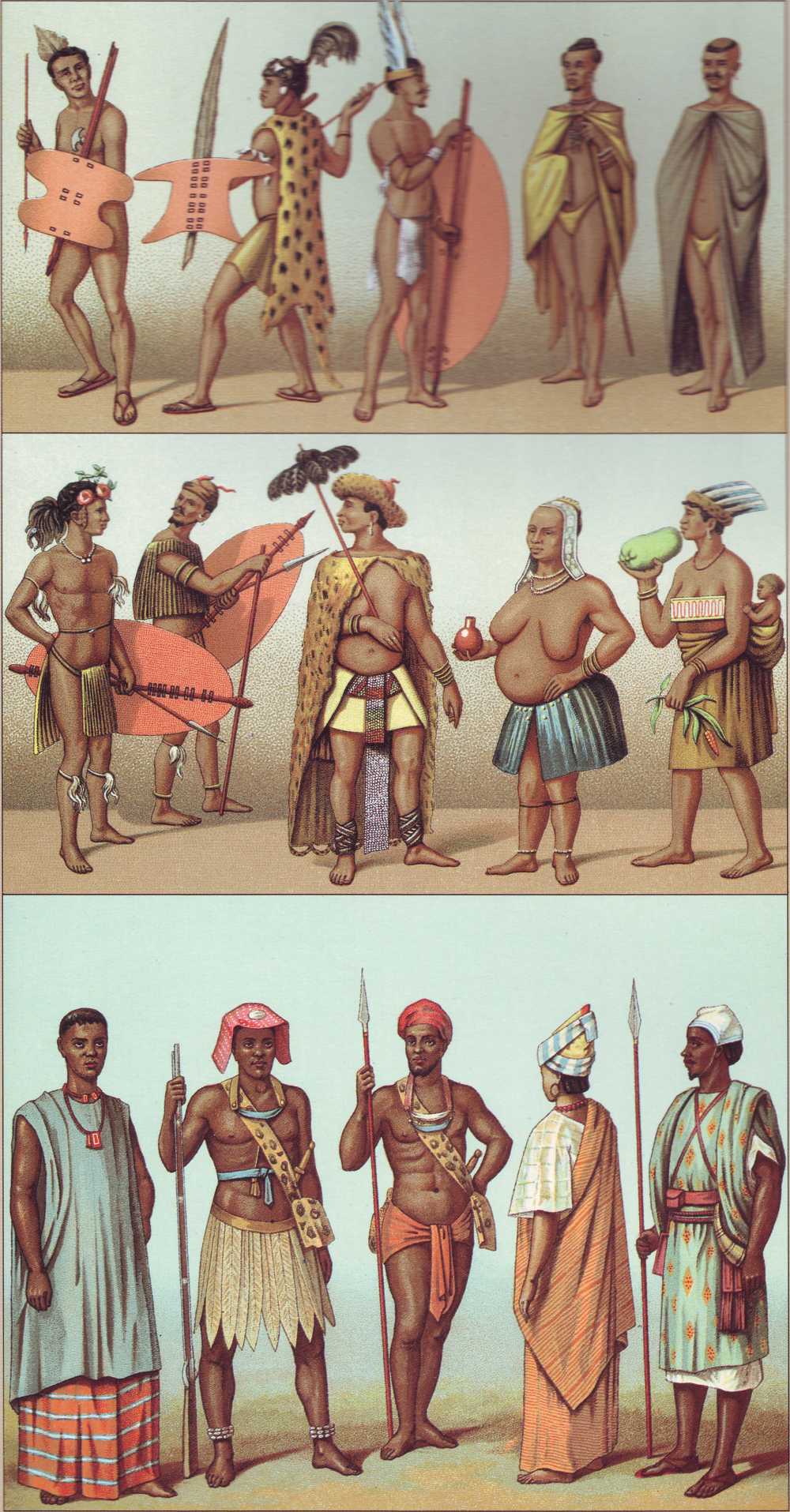|
THE HISTORICAL ENCYCLOPEDIA OF COSTUME
ALBERT RACINET
THE CLASSIC WORK OF THE 19TH CENTURY
p54-55
19TH CENTURY ANTIQUE CIVILIZATIONS
AFRICA
SOUTHERN AFRICA - SUDAN
THE XHOSAS, FROM SOUTHERN AFRICA, are a handsome people who take great care of their appearance. The equatorial climate means that they do not require much clothing and tattoos are the basis of the costume for both men and women. These tattoos have a heraldic function, with special designs denoting individual tribes. Men and women both oil their bodies heavily, the height of luxury for a woman being not just to rub perfumed oil into her skin, but to make her body shine with the oil. Before applying oil, men smear their faces and bodies with a red dye to which the women add sugar from a sweet-smelling plant.
This care of the body extends as far as removing the hair from all parts of the body except the armpits: both men and women shave off their eyebrows.
Various hairstyles are adopted, by men and women. Some cut their hair to leave only a large clump, which is woven into pieces of wood to form a latticed cone. Others shave the crown, plaiting the sides with fine strips, or keep tufts at the sides and weave them through pieces of brass.
Many women allow their hair to grow naturally long and curly: they use it as a sort of pin cushion in which to keep a knife or a pipe. Sometimes they plait their hair round strips of bark. This arrangement may take many days of work, but when finished it can last for six months or more.
The principal garment worn by the natives is a piece of animal skin with the fur worn against the skin. For a man, this is usually a simple loincloth; for a woman, it is more circular in shape, sometimes covering the entire body. The hunters carry assegais and shields made of animal skin. Around their necks are knives with handles of ivory or boxwood and round-ended blades. For long marches or hunting they wear leather sandals, held on with leather strips that pass over the instep and through the big toe.
1.1 A Bechuana warrior.
1.2 A Basotho hunter. The feathered instrument is meant to deceive game; it is stuck in the ground to attract inquisitive animals, and can be quickly retrieved to spear them.
1.3 A Xhosa from Grahamstown.
1.4 A Bechuana.
1.5 A Matabele.
2.1 & 2 Zulus.
2.3 A Bechuana tribeswoman in ceremonial costume.
2.4 A Matabele tribeswoman.
2.5 A Xhosa woman.
Click for a larger image of the upper register.

Click for a larger image of the middle register.
Click for a larger image of the lower register.
3 Senegalese tribesmen and women, from the lands by the River Senegal in Western Sudan. There are a large number of different tribes in Senegal, all with different styles of costume.
One style, left, is a long tunic worn with talismans around the neck. Next to him is a man wearing a pagne, made of dried leaves. With the man to his right, he is wearing leopard-skin shoulder straps with ammunition pouches attached at the waist.
The woman to their right wears a yellow turban with a blue and white striped border: headgear of mixed colours is a characteristic of Senegalese costume. Her chemise, worn underneath a carefully draped ferdah, another native garment, has comfortable wide sleeves.
The man on the far right is wearing the ample sleeves of his tunic rolled up over his shoulders.
Previous Next
Prints of Costume by Racinet
|

